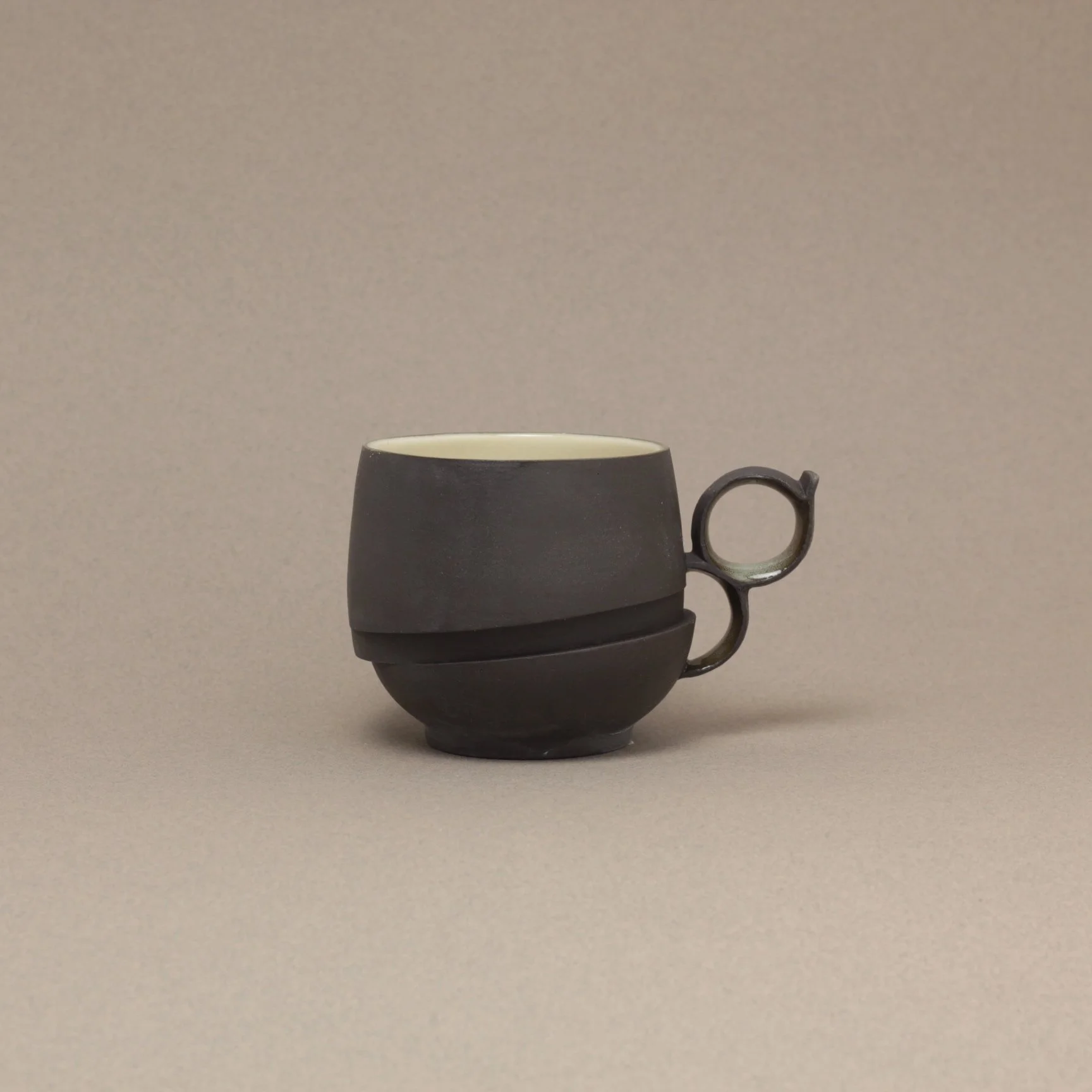The Making with Sam Kim
Pottery is, at its roots, a utilitarian medium. From the ancient kylix to the modern cup, ceramists continue to redefine how the forms of household objects can be realized. Sam Kim, a Lowell-based ceramicist specializing in mug, cup, and bowlware, continues to redefine the slipcasting technique through his minimalist “cut” slipcasting designs.
Slipcasting, a technique most common in industrial production, sees the ceramicist pour a clay-based slurry into a prefabricated mold. The slurry then evenly settles around the sides of the mold, allowing the artist to pull away and fire shapes that would be impossibly difficult to produce using more traditional methods. Even though Kim’s work may seem to be “cut” along well-defined sections, the slants in his designs are predetermined and cast as one.
Below is a conversation between Essex Art Center Gallery Attendant Connor D’Angelo and Sam Kim, diving deeper into Kim’s roots as an artist, his inspiration, and what he seeks to define through his very unique style.
Kim working in Slow Hands Studio at the Western Avenue Studios in Lowell.
CD:
Looking at your work, my attention is immediately drawn to the bold, dynamic, and geometric nature. In general, it seems to have very little connection with “natural geometry”–it’s much more man-made. Do you agree?
SK:
Yes, to an extent. With ceramics, you often see natural, fluid movement. My work is defined by slants in the casting—I call them offsets—and that stands out to people because it's hard to achieve. I think that speaks to what people find attractive, the combination of curves and straight cuts. This one, with the curve, is my best seller.
Kim’s work is defined by its contrasting “cuts” and sections, establishing intense juxtaposition within a thoroughly monochromatic medium.
CD:
Where do you find inspiration for these designs and curves? When I see your pieces, they immediately strike me as beautiful examples of Suprematism, an artistic movement in which “geometric feeling” is held above all else. Do you aim to achieve any sort of emotional goal in terms of what both the viewer and you, as an artist, feel via these geometric shapes?
SK:
I've never heard of that movement before, so it's great that you’ve brought it to my attention! I don't know if the emotion has to do with the geometry necessarily. There is a sense of uncomfortability that comes with an offset design, especially as it starts to offset more and more. And with the molds I make, I can slide them as far as they allow; the more I offset it, the more dramatic the cast.
CD:
You're speaking about your slipcasting molds. You make all the molds yourself; how did you get into this process?
SK:
I initially went to MassArt for industrial design. During my junior year, I really wanted to take wheel working, but it’s a popular class, so the only way to get in was to declare a minor in ceramics. Keep in mind I had never touched clay until this point. So I was like, “Why not? I don't have to finish my minor.” When I took my first mold making class, I developed this idea and ran with it. And now it’s been eight years!
I have done some sculpture in the past, but money is a thing I like to make (laughs). Utilitarian objects and ergonomics interest me, and I think it's the best of both worlds to make mugs and have sculpture in the back of my mind.
CD:
Changing gears, I noticed that a lot of your work is almost entirely either white or muted colors, without any painted designs. Is there a reason for this sort of minimalism?
SK:
I’ve been thinking about this a lot; it’s definitely aloadedquestion. American potters–not to say that it’s a bad thing–are very individualistic. And if you look at potters from Korea, they are very minimal, perfecting their craft in terms of form. So I think I was more attracted to that than what American potters typically do. Let me put it this way: Nobody has one mug that they use at home, they have multiple. If one is in the dishwasher, you take out another one. I think sets are a beautiful thing that ceramics can achieve; if there's a dinner party, you take out a set of things, and they're all working in harmony. Individualistic designs can take away from that. I want to get into ornamentation at some point, but it goes back to what has been most lucrative for me.
An outlier of Kim’s work, this piece is defined by its black exterior and cream interior. Most of Kim’s pieces exhibit single, neutral hues, allowing for contrast to be largely expressed through form.
CD:
Is there anything else you want to share about your work that you haven't had the chance to?
SK:
You asked me about what emotions I want to get out of my viewers. I get a lot of reactions of discomfort, and some even refuse to hold my cups. Viewers describe my work as ‘cut’ or ‘broken’. Words that imply that there was an original ‘normal’ form, and something happened to it. The shift happens in the mold, which means none of my cups were cut, and they are the strongest in the form they are in. If you tried to force my cups back to a “normal” form, you would end up breaking the cup.
We live in a society with many harmful standards of ‘normal’. One example of this that has been on my mind is homophobia and transphobia. Enforcing our own ideas of normalcy onto others can have hurtful consequences. I want to invite my viewers to challenge familiar ideas and expectations of normalcy. I hope my work can be a reminder to stay curious and open to unfamiliar and uncomfortable realities. That’s what’s great about making functional everyday objects—they can act as a daily reminder.
This interview was conducted by Connor D’Angelo and edited for clarity and comprehensibility.
About the artist: Sam Kim is a Korean-American artist and designer based in Lowell who is delicate in his craft and bold in his creativity. He strives to find the balance between the visual and functional—his objects and their beautiful forms find life through touch. He has a special love for good coffee and bikes, and you’ll find him researching new tech or playing his favorite video games in his free time. You can follow Sam via his Instagram, @samkimceramics, and you can support Sam and his studio partner Leena Cho, through Slow Hands Studio at https://www.slowhandsstudio.com
About the interviewer: Connor D’Angelo is a senior at Andover High School, planning on studying Art History and Chemistry at Tufts University. Aspiring to work in Museum Curation, Management, or Conservation, you can often find him baking.



